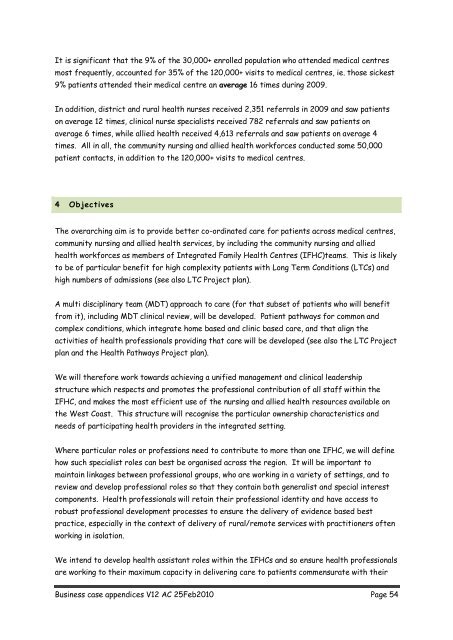Better Sooner More Convenient Primary Care - New Zealand Doctor
Better Sooner More Convenient Primary Care - New Zealand Doctor
Better Sooner More Convenient Primary Care - New Zealand Doctor
Create successful ePaper yourself
Turn your PDF publications into a flip-book with our unique Google optimized e-Paper software.
It is significant that the 9% of the 30,000+ enrolled population who attended medical centres<br />
most frequently, accounted for 35% of the 120,000+ visits to medical centres, ie. those sickest<br />
9% patients attended their medical centre an average 16 times during 2009.<br />
In addition, district and rural health nurses received 2,351 referrals in 2009 and saw patients<br />
on average 12 times, clinical nurse specialists received 782 referrals and saw patients on<br />
average 6 times, while allied health received 4,613 referrals and saw patients on average 4<br />
times. All in all, the community nursing and allied health workforces conducted some 50,000<br />
patient contacts, in addition to the 120,000+ visits to medical centres.<br />
4 Objectives<br />
The overarching aim is to provide better co-ordinated care for patients across medical centres,<br />
community nursing and allied health services, by including the community nursing and allied<br />
health workforces as members of Integrated Family Health Centres (IFHC)teams. This is likely<br />
to be of particular benefit for high complexity patients with Long Term Conditions (LTCs) and<br />
high numbers of admissions (see also LTC Project plan).<br />
A multi disciplinary team (MDT) approach to care (for that subset of patients who will benefit<br />
from it), including MDT clinical review, will be developed. Patient pathways for common and<br />
complex conditions, which integrate home based and clinic based care, and that align the<br />
activities of health professionals providing that care will be developed (see also the LTC Project<br />
plan and the Health Pathways Project plan).<br />
We will therefore work towards achieving a unified management and clinical leadership<br />
structure which respects and promotes the professional contribution of all staff within the<br />
IFHC, and makes the most efficient use of the nursing and allied health resources available on<br />
the West Coast. This structure will recognise the particular ownership characteristics and<br />
needs of participating health providers in the integrated setting.<br />
Where particular roles or professions need to contribute to more than one IFHC, we will define<br />
how such specialist roles can best be organised across the region. It will be important to<br />
maintain linkages between professional groups, who are working in a variety of settings, and to<br />
review and develop professional roles so that they contain both generalist and special interest<br />
components. Health professionals will retain their professional identity and have access to<br />
robust professional development processes to ensure the delivery of evidence based best<br />
practice, especially in the context of delivery of rural/remote services with practitioners often<br />
working in isolation.<br />
We intend to develop health assistant roles within the IFHCs and so ensure health professionals<br />
are working to their maximum capacity in delivering care to patients commensurate with their<br />
Business case appendices V12 AC 25Feb2010 Page 54

















